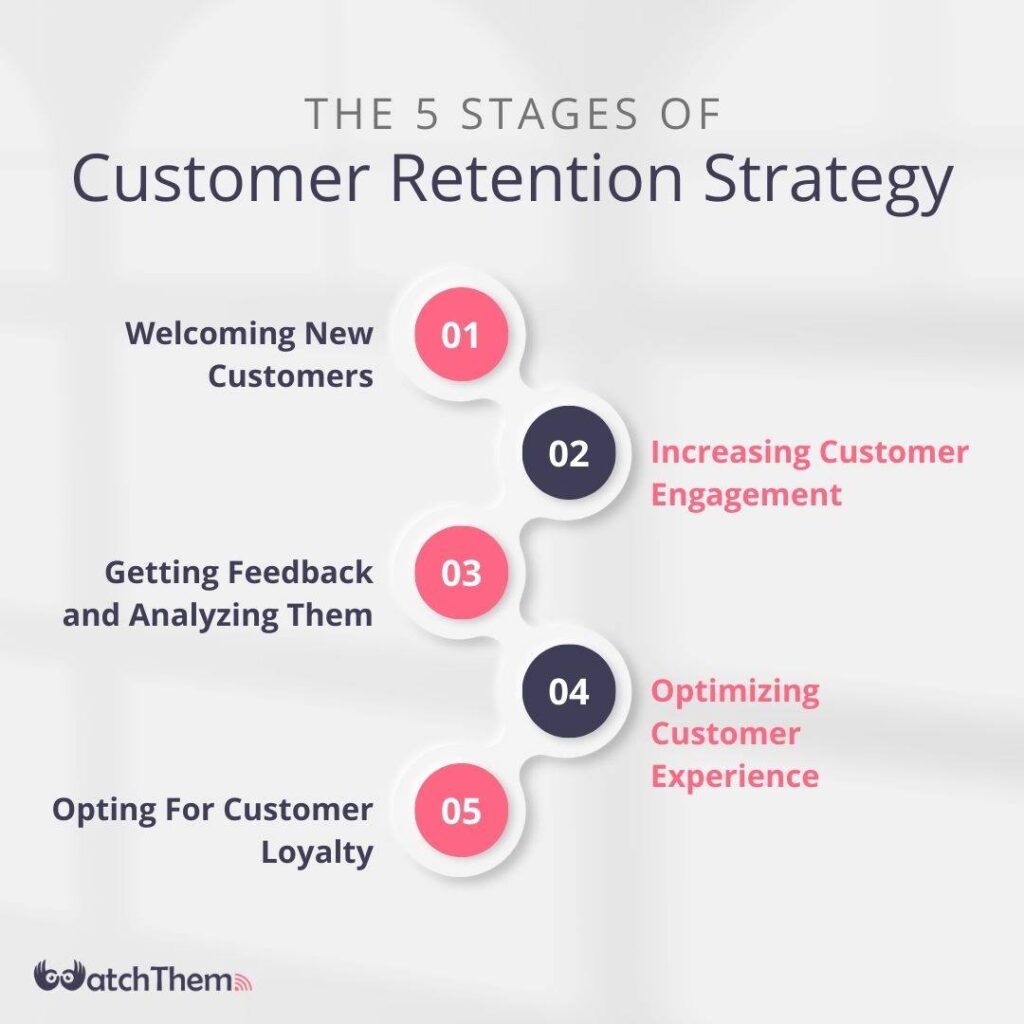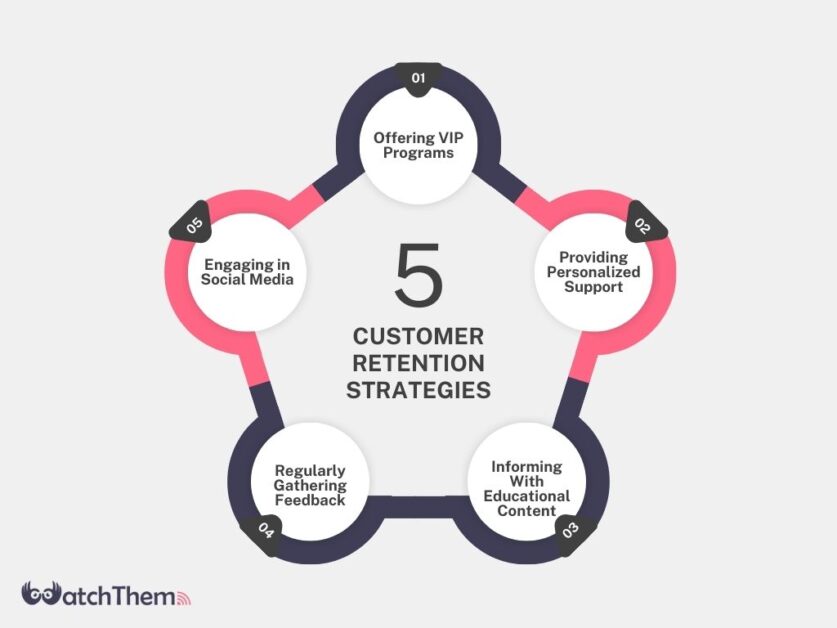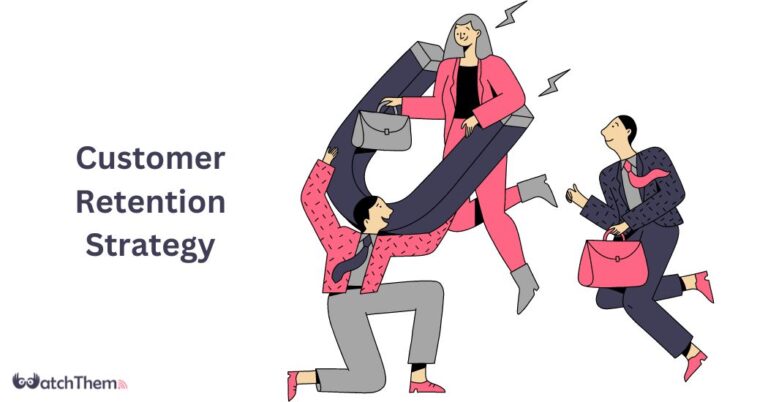Page Contents
Have you ever wondered why popular brands have such loyal customers? Some will go out of their way to convince others, even swear by it, that their brand is the best! There must be something special about the brand, maybe luck? Perhaps not.
Top brands worldwide know the value of their loyal customers and use customer retention strategies to turn their interactions with customers into meaningful connections. High customer retention rates indicate customers’ loyalty towards a brand, and you can’t “buy” someone’s loyalty (unless you are wealthy), but you have got to earn it.
In this blog, we’ll discuss the best customer retention strategies and their pillar stages, and we will also provide you with examples of how the top brands are doing it. But before that, we must understand customer retention strategies and grasp the scale of their positive impact on your marketing campaigns.
What Is a Customer Retention Strategy?
A plan that businesses use to increase their customer engagement over time is called a customer retention strategy. Instead of acquiring new customers and branding, customer retention strategies focus on customers’ journey and satisfaction.
Customer retention strategy involves developing desirable experiences and values that lead to customer loyalty rather than defection. High retention generally represents satisfied and loyal customers, and they are essential for the sustainability of any business.
How Can Customer Retention Strategies Help Us?
Targeting the top customer retention metrics, such as churn rate, repeat purchase rate, and engagement rate, will ensure the success of a strategy. And trust us, a well-thought-out customer retention strategy can be beneficial to any brand. In what ways, you ask?
Customer retention strategies can help us with:
- Turning new customers into loyal ones who are more valuable.
- Lowering costs by retaining customers instead of acquiring new ones.
- Better word of mouth about your brand
As a rule of thumb, it is easier to improve relations with loyal customers than to find new ones. As the loyalty of a customer increases, they keep coming back for more, and loyal customers are most likely to recommend your brands to friends and relatives… free advertisements!
Whereas if customers have had a bad experience while engaging with your brand, they are more likely to make your brand’s reputation go downhill. So, it is wise for marketers to realize when they should pay for ads that will result in new customers and brand awareness or shift their focus toward customer retention strategies. If the latter was the best option, then how can it be implemented? What are the stages of a good customer retention strategy?
The 5 Stages Of Customer Retention Strategy
For a customer retention strategy to be successful, it must follow five stages, which will guide the brand’s efforts toward not only better retention rates but also long-lasting relationships. The five main stages of customer retention strategies (that must be followed are):


#1 Welcoming New Customers
After obtaining new customers, whether via ads or any other way, analyze them and greet them in a personalized way. With a good customer acquisition and retention strategy, and putting effort into giving customers an enjoyable and easy first experience, you will leave them with a lingering positive memory about your brand in their mind. So, maybe you should focus on giving them their needed information instead of trying to sell them your products.
#2 Increasing Customer Engagement
Imagine the regular customers in your mind; what makes them come back? Is it the product? Or the service and relationship?
When you go to your favorite coffee shop, you’d be happy if they knew your usual order, right? This is one way that personalized experience can leave a smile on the customers’ faces.
So, in this stage, find out what factors make your customers choose your brand over and over again, and improve them as it will directly improve customer engagement and relationship with the brand.
#3 Getting Feedback and Analyzing Them
What if, for one or two days, a regular doesn’t show up? You’ll probably wonder why. By finding the reasons for your customers’ sudden disappearance, you can solve them and make them regulars again.
Getting feedback from your customers is one of the keys in this stage. Feedback from regular customers can help prevent dissatisfaction, ensuring customer retention.
#4 Optimizing Customer Experience
When customers see their feedback is valued and executed, they’ll feel worthy. Rather than feeling like walking moneybags, they’ll realize your attention to detail regarding their interests, and this will take you one step closer to loyal customers who keep coming back.
#5 Opting For Customer Loyalty
After you value your customers and improve their relationship with your brand, you can celebrate having loyal customers… but not for long.
Loyal customers are true assets to brands, so extra effort is required to keep them. One effective customer retention program is to give them discounts, VIP benefits, appreciation gifts, and such.
After doing these five customer retention strategy stages and gaining loyal customers, you’ll realize that their value is unmatched. A loyal customer is not merely a direct revenue source but is also a walking advertisement and a very fine one. The kind that is the most cost-efficient as well as impactful and can’t be put on billboards either.
Top 5 Customer Retention Strategies in 2024 + Examples
Many famous brands use innovation to come up with new customer retention strategies. But, to be honest, we can roughly say that the main idea behind customer retention strategies can be explained by two things: Personalized experience & relationship building.
While the idea is set in stone, you can still use the customer retention strategy examples of top brands and experiment with what works best for you.


#1 Offering VIP Programs
Offering rewards for the most loyal customers in the form of VIP programs will make them feel special. Such client retention programs should offer advantages that other customers do not have, including special product access, discounts, or personalized service. The focus here is on appreciating the customers’ loyalty, which makes them feel special.
Example: Amazon Prime has an effective VIP program. Prime members are offered a range of benefits, such as free two-day delivery, access to various streaming services, and many shopping offers and discounts. Not only does this Amazon customer retention strategy encourage users to stay loyal, but it also makes them more interested in Amazon’s special offers.
#2 Providing Personalized Support
Personalized support is not just answering customer questions and calls; it involves understanding the customer’s history with the brand, their preferences, and their purchasing behavior and using them to ensure their satisfaction after their engagement. This approach shows customers that they are known and valued by the brand.
Example: Netflix’s recommendation algorithm is a form of personalized support. While it’s not traditional customer service, it provides personalized suggestions based on viewing history, enhancing the user experience and keeping customers engaged and subscribed.
#3 Informing With Educational Content
The educational content ensures that customers make the best purchases for their needs and also solves some common problems they may encounter. Such content can be in the form of blogs, video tutorials, webinars, or FAQs. Also, good content design can make your brand’s image more appealing, which wins the trust of customers.
Example: HubSpot is a master of this approach. They have a massive library of blogs, e-books, and tutorials not only on their products but also about general marketing, sales, and customer service. This method aids in customer retention by consistently providing value.
#4 Regularly Gathering Feedback
Regular feedback collection shows customers that you care about their opinions and are committed to improving their experience. It can be done through surveys and feedback forms on your website, or even through social media polls. Acting on this feedback is crucial for showing customers that their voice matters.
Example: Airbnb regularly asks for feedback after each stay. This feedback is used to rate hosts and properties, ensuring quality control and improving the experience for future guests. It’s a cycle that continually enhances service quality and customer satisfaction.
#5 Engaging in Social Media
There is more to social media engagement than just posting about your products or services. It can help customers massively with initiating and engaging in conversations, replying to comments, telling customer stories, and making content that your audience can relate to. Engaging through social media effectively turns customers into loyalists.
Example: GoPro Heroes is a platform where people share their user-generated content. The company receives adventure videos shot with GoPro cameras and shares them on its various platforms. This type of strategy not only demonstrates their product in action but also creates a community that is loyal and interactive.
FAQs
So far, we have discussed why it is sometimes more beneficial to retain previous customers instead of new ones. We also explained the stages of content retention strategies and how they help you towards an increase in the loyalty of your customers. But before we end this guide, we want to answer some of the frequently asked questions about the subject.
Q1. Which Practice Helps A Company Retain Customers?
Treating customers with respect helps a company retain customers. As we know, customers are the heart of any business and by showing your care to them and respecting them and their needs, you can earn their loyalty.
Q2. What Are The 8 C’s Of Customer Retention?
The 8 important factors, or the 8 C’s in customer retention consist of community, care, convenience, customer connection, cultivation, customization, character, and choice. All of these factors serve a role in customer retention strategies and can help you gain better online customer loyalty, or e-loyalty for short.
Conclusion
Customer retention strategies are not just about selling more products; They’re about connecting with the audience and then giving them what they need, whether a product or a service. Remember that the bottom line of marketing strategies is understanding, changing with, and growing with your customers.
Now, armed with knowledge about customer retention, its stages, and strategies in your arsenal, you are ready to take on the challenge of forming a business around customers… and we’re sure that by asking the right questions, you’ll get the right results.

